Manajemen Rehabilitasi Fisioterapi pada Bayi dengan Spastic Cerebral Palsy: Laporan Kasus
DOI:
https://doi.org/10.57213/jrikuf.v3i3.760Keywords:
Cerebral palsy, spastic, physiotherapy, head control, motor developmentAbstract
Cerebral palsy (CP) is a non-progressive motor disorder caused by early brain injury. The spastic type is characterized by increased muscle tone and limited voluntary movement, often leading to delayed gross motor development in children. This case report aims to describe physiotherapy management in a spastic CP infant and evaluate the response after two weeks of intervention. The patient was a 10-month-old male infant (corrected age 8 months 19 days) with a history of prematurity, neonatal asphyxia, and diagnosed with spastic CP. Physiotherapy interventions included neurosensory stimulation, Bobath positioning, head and trunk control training, and a home program provided to the parents. Evaluation was conducted through clinical observation and the Hammersmith Infant Neurological Examination (HINE). After two weeks of therapy, the patient showed minor improvement in head control and reduced head lag, but no significant development in gross motor skills such as rolling or sitting. HINE score was 34, indicating a non-ambulatory prognosis. Short-term physiotherapy management in spastic CP can support early postural control, but long-term intervention and strong family involvement are essential to achieve optimal motor development.
References
Anttila, H., Autti-Rämö, I., Suoranta, J., Mäkelä, M., & Malmivaara, A. (2008). Effectiveness of physical therapy interventions for children with cerebral palsy: A systematic review. Developmental Medicine & Child Neurology, 50(7), 463–470. https://doi.org/10.1111/j.1469-8749.2008.03063.x
Damiano, D. L. (2006). Activity, activity, activity: Rethinking our physical therapy approach to cerebral palsy. Physical Therapy, 86(11), 1534–1540. https://doi.org/10.2522/ptj.20050265
Ferriero, D. M. (2004). Neonatal brain injury. The New England Journal of Medicine, 351(19), 1985–1995. https://doi.org/10.1056/NEJMra041996
Graham, H. K., Rosenbaum, P., Paneth, N., Dan, B., Lin, J. P., Damiano, D. L., Becher, J. G., Gaebler-Spira, D., Colver, A., Reddihough, D. S., Crompton, K. E., & Lieber, R. L. (2016). Cerebral palsy. Nature Reviews Disease Primers, 2, 15082. https://doi.org/10.1038/nrdp.2015.82
King, G., King, S., Rosenbaum, P., & Goffin, R. (2004). Family‐centered caregiving and well‐being of parents of children with disabilities: Linking process with outcome. Child: Care, Health and Development, 30(1), 15–28. https://doi.org/10.1111/j.1365-2214.2004.00382.x
Morgan, C., Novak, I., & Badawi, N. (2016). Enriched environments and motor outcomes in cerebral palsy: Systematic review and meta‐analysis. Pediatrics, 138(3), e20160217. https://doi.org/10.1542/peds.2016-0217
Novak, I., McIntyre, S., Morgan, C., Campbell, L., Dark, L., Morton, N., Stumbles, E., Wilson, S. A., & Goldsmith, S. (2013). A systematic review of interventions for children with cerebral palsy: State of the evidence. Developmental Medicine & Child Neurology, 55(10), 885–910. https://doi.org/10.1111/dmcn.12246
Novak, I., Morgan, C., Fahey, M., Finch-Edmondson, M., Galea, C., Hines, A., Langdon, K., Dark, L., Morton, N., & Goldsmith, S. (2020). State of the evidence traffic lights 2020: Systematic review of interventions for preventing and treating children with cerebral palsy. Pediatrics, 145(1), e20193467. https://doi.org/10.1542/peds.2019-3467
O’Shea, T. M. (2008). Diagnosis, treatment, and prevention of cerebral palsy. Clinical Obstetrics and Gynecology, 51(4), 816–828. https://doi.org/10.1097/GRF.0b013e3181870ba7
Oskoui, M., Coutinho, F., Dykeman, J., Jetté, N., & Pringsheim, T. (2013). An update on the prevalence of cerebral palsy: A systematic review and meta-analysis. Developmental Medicine & Child Neurology, 55(6), 509–519. https://doi.org/10.1111/dmcn.12080
Panturin, E., Vorontsova, M., & Belova, A. (2021). The effectiveness of the Bobath concept in rehabilitation of children with cerebral palsy: Systematic review. Physiotherapy Theory and Practice, 37(3), 338–345. https://doi.org/10.1080/09593985.2019.1626059
Rosenbaum, P., Paneth, N., Leviton, A., Goldstein, M., & Bax, M. (2007). A report: The definition and classification of cerebral palsy April 2006. Developmental Medicine & Child Neurology Supplement, 109, 8–14. https://doi.org/10.1111/j.1469-8749.2007.tb12610.x
Downloads
Published
Issue
Section
License
Copyright (c) 2025 Jurnal Riset Ilmu Kesehatan Umum dan Farmasi (JRIKUF)

This work is licensed under a Creative Commons Attribution-ShareAlike 4.0 International License.






